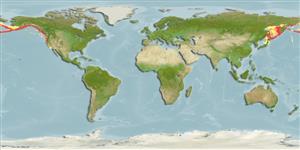Ikan bertulang rawan (sharks and rays) >
Rajiformes (Skates and rays) >
Arhynchobatidae (Softnose skates)
Etymology: Bathyraja: Greek, bathys = deep + Latin, raja, -ae = a ray (Raja sp) (Ref. 45335); interrupta: Name refers to the interrupted row of thorns down the middorsal and tail..
More on authors: Gill & Townsend.
Environment: milieu / climate zone / depth range / distribution range
Ekologi
laut batidemersal; kisaran kedalaman 23 - 1500 m (Ref. 27436), usually 200 - 500 m (Ref. 126515). Deep-water
North Pacific: Bering Sea, Alaska south to British Columbia, Canada.
Size / Weight / umur
Maturity: Lm ? range ? - ? cm
Max length : 89.0 cm TL jantan/; (Ref. 126515)
deskripsi pendek
Morfologi | Morfometrik
This moderately-sized skates (82.5 cm TL) with disc length (47.7-54.0% TL) are distinguished by the following; head length moderate (18.4-21.4% TL), posterior lobe of pelvic fins are long (10.4-23.4% TL); claspers are long and robust, tip rounded and not bulbous, no pseudosiphon, with a weak, but long pseudorhipidion, U-shaped cleft, projection rounded and protrudes from tip, has a very large sentina, sentinel present; teeth in 22-32 rows on upper jaw, teeth in 23-32 rows on lower jaw; total vertebrae 133; dorsal surface covered in small, sandpaper-like prickles; thorns in a non-continuous row, mature males with strong alar thorns, no malar thorns, middorsal thorns strong (1-8), nuchal thorns robust (2-5), tail thorns moderate (18-26), interdorsal thorns weak (0-1). Colouration: dorsal brown to grey, with numerous small dark spots on body; ventral white, often with dark brown blotches on underside of tail (Ref. 126515).
Inhabit the outer continental shelf, on mud or sand bottoms (Ref. 27436). Frequently found buried in substrate (Ref. 27436). Feed on benthic invertebrates including euphausiids, crabs, and various shrimps (e.g., pandalids, hippolytids, crangonids) and bony fishes. Reported size at maturity for males is 69-70 cm TL and for females 71-72 cm TL, with a maximum size of at least 89 cm TL (Ref. 126515). Oviparous. Distinct pairing with embrace. Young may tend to follow large objects, such as their mother (Ref. 205). Eggs are deposited in sandy or muddy flats (Ref. 205). Egg cases are small (7.8-7.9 cm TL), colour golden brown, covered with small and coarse prickles that form longitudinal rows. The egg cases with lateral keels very wide, horns taper and become thin and filamentous at their ends, with the anterior horn being more robust (Ref. 126515). Although the pectoral fins may be used to prepare a variety of dishes, they are generally considered not saleable, and incidental catches are usually discarded (Ref. 27436). Occasionally used to produce mink feed and fertilizer (Ref. 27436). Minimum depth reported from Ref. 6793.
Oviparous, paired eggs are laid. Embryos feed solely on yolk (Ref. 50449). Distinct pairing with embrace. Young may tend to follow large objects, such as their mother (Ref. 205).
Knuckey, J.D.S. and D.A. Ebert, 2022. A taxonomic revision of Northeast Pacific softnose skates (Rajiformes: Arhynchobatidae: Bathyraja Ishiyama). Zootaxa 5142(1):1-89. (Ref. 126515)
Status IUCN Red List (Ref. 130435)
ancaman kepada manusia
Harmless
penggunaan manusia
informasi lanjut
AcuanBudidaya airprofil budidaya airStrainGenetikaElectrophoresesDiturunkanPenyakit-penyakitPengolahanNutrientsMass conversion
mitraGambarStamps, Coins Misc.Suara-suaraCiguateraKecepatanTipe renangArea insangOtolithsOtakPenglihatan / visi
Alat, peralatan
laporan khas
muat turun XML
Sumber internet
Estimates based on models
Preferred temperature (Ref.
123201): 1 - 5.4, mean 2.1 °C (based on 298 cells).
Phylogenetic diversity index (Ref.
82804): PD
50 = 0.5000 [Uniqueness, from 0.5 = low to 2.0 = high].
Bayesian length-weight: a=0.00468 (0.00309 - 0.00707), b=3.05 (2.93 - 3.17), in cm total length, based on LWR estimates for this species & Genus-body shape (Ref.
93245).
Trophic level (Ref.
69278): 3.4 ±0.46 se; based on food items.
Daya lenting (Ref.
120179): sangat rendah, Waktu penggandaan populasi minimum lebih dari 14 tahun (Fec=6).
Fishing Vulnerability (Ref.
59153): High to very high vulnerability (68 of 100).
Nutrients (Ref.
124155): Calcium = 6.86 [1.23, 37.25] mg/100g; Iron = 0.31 [0.08, 1.00] mg/100g; Protein = 15.3 [12.7, 17.9] %; Omega3 = 0.488 [0.155, 1.875] g/100g; Selenium = 15.6 [4.2, 49.6] μg/100g; VitaminA = 8.6 [2.0, 38.8] μg/100g; Zinc = 0.38 [0.19, 0.71] mg/100g (wet weight);
